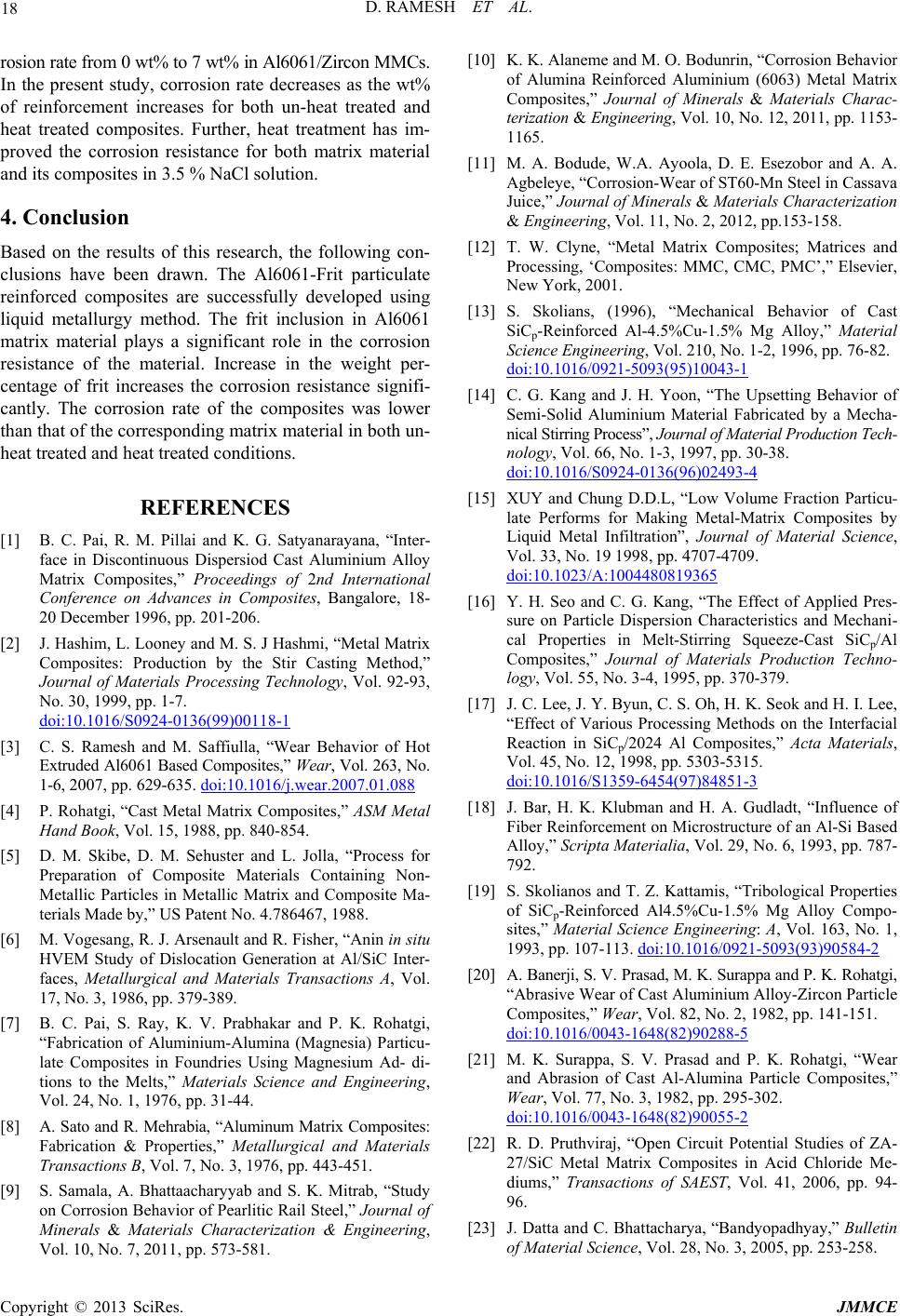
D. RAMESH ET AL.
18
rosion rate from 0 wt% to 7 wt% in Al6061/Zircon MMCs.
In the present study, corrosion rate decreases as the wt%
of reinforcement increases for both un-heat treated and
heat treated composites. Further, heat treatment has im-
proved the corrosion resistance for both matrix material
and its composites in 3.5 % NaCl solution.
4. Conclusion
Based on the results of this research, the following con-
clusions have been drawn. The Al6061-Frit particulate
reinforced composites are successfully developed using
liquid metallurgy method. The frit inclusion in Al6061
matrix material plays a significant role in the corrosion
resistance of the material. Increase in the weight per-
centage of frit increases the corrosion resistance signifi-
cantly. The corrosion rate of the composites was lower
than that of the corresp onding matrix material in b o th un-
heat treated and heat treated conditions.
REFERENCES
[1] B. C. Pai, R. M. Pillai and K. G. Satyanarayana, “Inter-
face in Discontinuous Dispersiod Cast Aluminium Alloy
Matrix Composites,” Proceedings of 2nd International
Conference on Advances in Composites, Bangalore, 18-
20 December 1996, pp. 201-206.
[2] J. Hashim, L. Looney and M. S. J Hashmi, “Metal Ma trix
Composites: Production by the Stir Casting Method,”
Journal of Materials Processing Technology, Vol. 92-93,
No. 30, 1999, pp. 1-7.
doi:10.1016/S0924-0136(99)00118-1
[3] C. S. Ramesh and M. Saffiulla, “Wear Behavior of Hot
Extruded Al6061 Based Comp osites,” Wear, Vol. 263, No.
1-6, 2007, pp. 629-635. doi:10.1016/j.wear.2007.01.088
[4] P. Rohatgi, “Cast Metal Matrix Composites,” ASM Metal
Hand Book, Vol. 15, 1988, pp. 840-854.
[5] D. M. Skibe, D. M. Sehuster and L. Jolla, “Process for
Preparation of Composite Materials Containing Non-
Metallic Particles in Metallic Matrix and Composite Ma-
terials Made by,” US Patent No. 4.786467, 1988.
[6] M. Vogesang, R. J. Arsenault and R. Fisher, “Anin in situ
HVEM Study of Dislocation Generation at Al/SiC Inter-
faces, Metallurgical and Materials Transactions A, Vol.
17, No. 3, 1986, pp. 379-389.
[7] B. C. Pai, S. Ray, K. V. Prabhakar and P. K. Rohatgi,
“Fabrication of Aluminium-Alumina (Magnesia) Particu-
late Composites in Foundries Using Magnesium Ad- di-
tions to the Melts,” Materials Science and Engineering,
Vol. 24, No. 1, 1976, pp. 31-44.
[8] A. Sato and R. Mehrabia, “Aluminum Matrix Composites:
Fabrication & Properties,” Metallurgical and Materials
Transactions B, Vol. 7, No. 3, 1976, pp. 443-451.
[9] S. Samala, A. Bhattaacharyyab and S. K. Mitrab, “Study
on Corrosion Behavior of Pearlitic Rail Steel ,” Journal of
Minerals & Materials Characterization & Engineering,
Vol. 10, No. 7, 2011, pp. 573-581.
[10] K. K. Alaneme and M. O. Bodunrin, “Corrosion Behavior
of Alumina Reinforced Aluminium (6063) Metal Matrix
Composites,” Journal of Minerals & Materials Charac-
terization & Engineering, Vol. 10, No. 12, 2011, pp. 1153-
1165.
[11] M. A. Bodude, W.A. Ayoola, D. E. Esezobor and A. A.
Agbeleye, “Corrosion-Wear of ST60-Mn Steel in Cassava
Juice,” Journal of Minerals & Materials Characterization
& Engineering, Vol. 11, No. 2, 2012, pp.153-158.
[12] T. W. Clyne, “Metal Matrix Composites; Matrices and
Processing, ‘Composites: MMC, CMC, PMC’,” Elsevier,
New York, 2001.
[13] S. Skolians, (1996), “Mechanical Behavior of Cast
SiCp-Reinforced Al-4.5%Cu-1.5% Mg Alloy,” Material
Science Engineering, Vol. 210, No. 1-2, 1996, pp. 76-82.
doi:10.1016/0921-5093(95)10043-1
[14] C. G. Kang and J. H. Yoon, “The Upsetting Behavior of
Semi-Solid Aluminium Material Fabricated by a Mecha-
nical Stirring Process”, Journal of Materia l Production Tech-
nology, Vol. 66, No. 1-3, 1997, pp. 30-38.
doi:10.1016/S0924-0136(96)02493-4
[15] XUY and Chung D.D.L, “Low Volume Fraction Particu-
late Performs for Making Metal-Matrix Composites by
Liquid Metal Infiltration”, Journal of Material Science,
Vol. 33, No. 19 1998, pp. 4707-4709.
doi:10.1023/A:1004480819365
[16] Y. H. Seo and C. G. Kang, “The Effect of Applied Pres-
sure on Particle Dispersion Characteristics and Mechani-
cal Properties in Melt-Stirring Squeeze-Cast SiCp/Al
Composites,” Journal of Materials Production Techno-
logy, Vol. 55, No. 3-4, 1995, pp. 370-379.
[17] J. C. Lee, J. Y. Byun, C. S. Oh, H. K. Seok and H. I. Lee,
“Effect of Various Processing Methods on the Interfacial
Reaction in SiCp/2024 Al Composites,” Acta Materials,
Vol. 45, No. 12, 1998, pp. 5303-5315.
doi:10.1016/S1359-6454(97)84851-3
[18] J. Bar, H. K. Klubman and H. A. Gudladt, “Influence of
Fiber Reinforcement on Microstructure of an Al-Si Based
Alloy,” Scripta Materialia, Vol. 29, No. 6, 1993, pp. 787-
792.
[19] S. Skolianos and T. Z. Kattamis, “Tribological Properties
of SiCp-Reinforced Al4.5%Cu-1.5% Mg Alloy Compo-
sites,” Material Science Engineering: A, Vol. 163, No. 1,
1993, pp. 107-113. doi:10.1016/0921-5093(93)90584-2
[20] A. Banerji, S. V. Prasad, M. K. Surappa and P. K. Rohatgi,
“Abrasive Wear of Cast Aluminium Alloy-Zircon Particle
Composites,” Wear, Vol. 82, No. 2, 1982, pp. 141-151.
doi:10.1016/0043-1648(82)90288-5
[21] M. K. Surappa, S. V. Prasad and P. K. Rohatgi, “Wear
and Abrasion of Cast Al-Alumina Particle Composites,”
Wear, Vol. 77, No. 3, 1982, pp. 295-302.
doi:10.1016/0043-1648(82)90055-2
[22] R. D. Pruthviraj, “Open Circuit Potential Studies of ZA-
27/SiC Metal Matrix Composites in Acid Chloride Me-
diums,” Transactions of SAEST, Vol. 41, 2006, pp. 94-
96.
[23] J. Datta and C. Bhattacharya, “Bandyopadhyay,” Bulletin
of Material Science, Vol. 28, No. 3, 2005, pp. 253-258.
Copyright © 2013 SciRes. JMMCE